How and what to feed currants in June: the best fertilizers and the rules for their introduction
Currants are not only black, white and red, but even yellow, purple and orange. This is one of the most common berry crops in the plots of Russian gardeners. At the same time, it is not so easy to get a harvest of large tasty berries, because currants are demanding on the presence of nutrients in the soil.
In June, berry bushes, in particular black currant, begin to form a crop. Therefore, it is especially important at this time that the plants receive enough nutrients and moisture. You will find detailed information on what and how to feed currants in June in our article.
The content of the article
Fertilization target in June
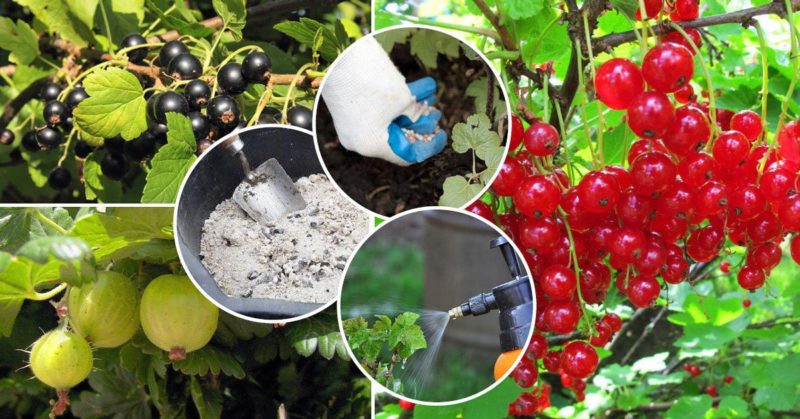
Fertilizing under blackcurrant bushes in June is a guarantee of obtaining sweet and large berries. Indeed, it is during this period that the active growth of shoots and the formation of fruits occurs.
Of berry crops, black currant, gooseberry and raspberry are the most demanding for the presence of nutrients in the soil. Only young shoots bear fruit intensively.
Important! Mineral and organic fertilizers alternate, maintaining the interval between dressings for about 2 weeks.
To ensure the growth of young branches, fast-acting nitrogen fertilizers, as well as organics (for example, a solution of slurry or poultry manure and water), are optimal. Top dressing combined with abundant watering of shrubs.
Optimal timing
If the berry was not fertilized in the fall, the first feeding is carried out at the very beginning of spring, together with the melting of the snow, when the plants wake up and start growing.
If fertilizers have already been applied in the fall, a new portion is applied after the beginning of flowering - in the second half of May - early June. Another feeding is carried out during the formation of the ovaries.
Fertilizers
The culture is fed with mineral and organic fertilizers, as well as using folk remedies.
Mineral fertilizers
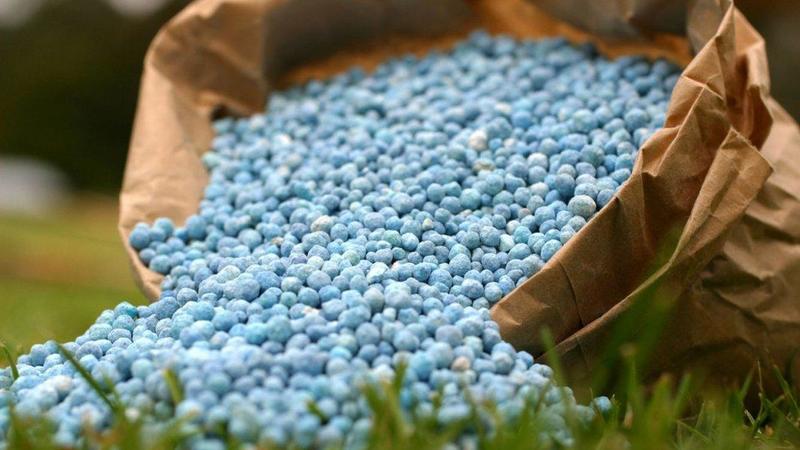
They contain concentrated fast-acting salts. According to the active chemical element, mineral additives are divided into phosphorus, potassium and nitrogen. Also on sale there are poly fertilizers containing several components at once.
For the first spring top dressing (during the snow melting period), dry nitroammofoska is used. The dosage is observed in accordance with the instructions for the preparation (10-15 g for a black currant bush and 8-10 g for red).
The second time the plants are fed during the flowering period (late May - early June). Phosphate-potassium fertilizers are used in the following dosage: 8-10 g of potassium sulfate or 10-12 g of superphosphate in dissolved form for each plant.
The third application of nutrients coincides with the period of ovary formation (as a rule, it occurs in June). This time, wood ash is used (100-150 g for black currants and 200 g for colored).
The fourth and fifth dressings are carried out after harvest and before the plant goes into hibernation. The fourth time - again with phosphorus and potassium fertilizers (5-10 g of potassium sulfate or superphosphate in dissolved form under a bush). Fifth - 300 g of wood ash for each plant.
Interesting fact! Russia ranks first in the world in terms of currant cultivation.
Organic fertilizers
Organic matter is of natural origin (animal or vegetable).This type of fertilizer includes manure, droppings, humus, compost, peat, etc. When decomposed, they form compounds that stimulate the development of microorganisms and beneficial bacteria that help plants to absorb nutrients from the soil.
Attention! Organic fertilizers provide air-water balance in roots, stems and leaves of plants.
Common natural organic fertilizer is manure and bird droppings. It is used in spring and June.
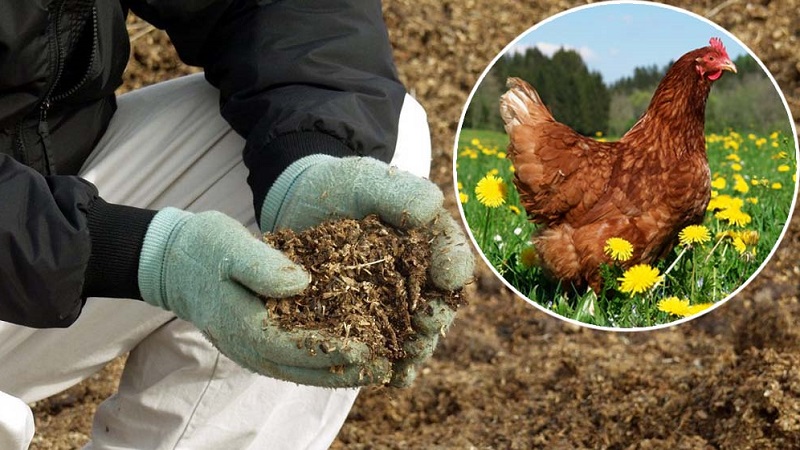
Overripe manure is diluted with water in a ratio of 1: 5. When watering, spend 1 bucket per adult bush or 1/2 for a young one. If the manure is fresh, it is poured with water and left for 3-4 days. Then diluted and watered.
Poultry droppings are mixed with water in a ratio of 1:12. The consumption is the same: for an adult bush - 1 bucket, for a young one - 1/2.
Compost and humus do not contain nitrogen, so they are used throughout the summer. With these fertilizers, it is convenient to mulch the soil around the currant bushes after watering or loosening with a layer of about 1 cm.
Folk remedies
For feeding black currants are also used in folk recipes. They are good as a supplement to mineral and organic fertilizers, but they cannot fully replace them.
Potato peelings
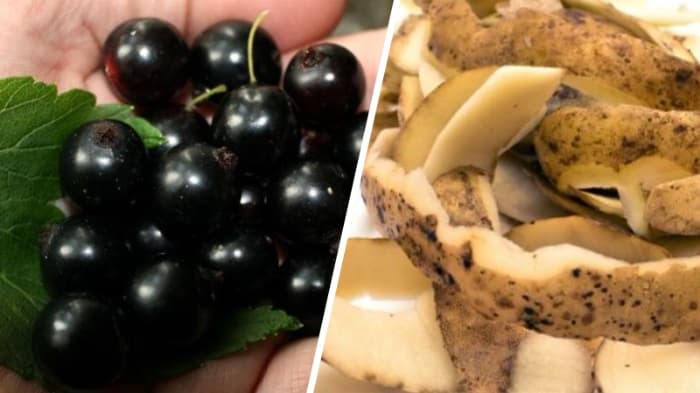
The benefits of infusion from potato peelings are due to the high content of starch in them. Raw materials are poured with water in a 1: 1 ratio and infused for a month. The resulting concentrate is diluted with water 1:10 and the plants are watered (1 bucket per bush). Such feeding is good during the period of berry formation.
If a potato peelings it is inconvenient to collect, ready-made starch is used. In this case, jelly is boiled from 100 g of starch and 2.5 liters of water, diluted in a bucket of water and watered.
Bread
Another effective folk remedy is bread fertilizer. One of the main ingredients in baked goods is yeast. They contain nutrients that stimulate plant growth. Such top dressing improves the structure of the soil, enhances the activity of living microorganisms, and increases the efficiency of the early organic matter (manure and droppings).
Council. Use grain fertilizer no more than 2-3 times per season, otherwise the acidity of the soil will increase.
Both fresh bread and stale bread harvested throughout the winter are suitable for preparing the nutrient mixture. Before use, the peel is folded into a bucket, poured over with warm water, covered with a lid and placed in a warm place for a week. Filter the finished fertilizer, dilute with water in a ratio of 1:10 and water the bushes.
Weed infusion
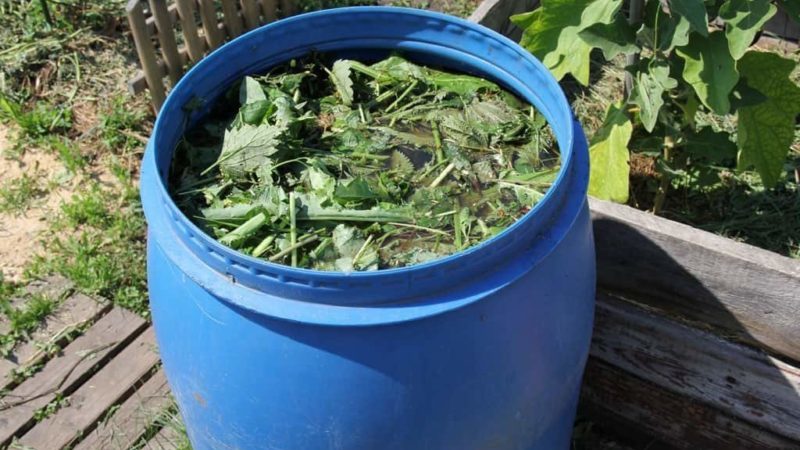
For the preparation of fertilizer, ordinary weeds that have just been removed from the beds are suitable. The grass is placed in a 1/2 barrel, filled with water, covered with foil and placed in the sun. To speed up fermentation add 3-4 tbsp. l. urea.
After a few days, foam appears on the surface, the mixture begins to ferment, and increases in volume. When the liquid brightens and the foam stops forming, the fertilizer is ready. This usually takes 1-2 weeks. The solution is diluted with water in a ratio of 1:10 and the bushes are watered.
Attention! The unpleasant odor that appears during the fermentation of the infusion neutralizes the valerian extract added to the container.
The ready-made nutritional mixture is not stored, but used immediately. Such feeding is useful not only for currants, but also for other crops (cabbage, tomatoes, cucumbers, greens).
Siderata
To provide black currants with the necessary nutrients, the use of green manure allows. It is enough to sow lupines, peas, vetch in the aisles in the spring, and in the fall to dig up the green manure together with the mown greens.
Coffee grounds
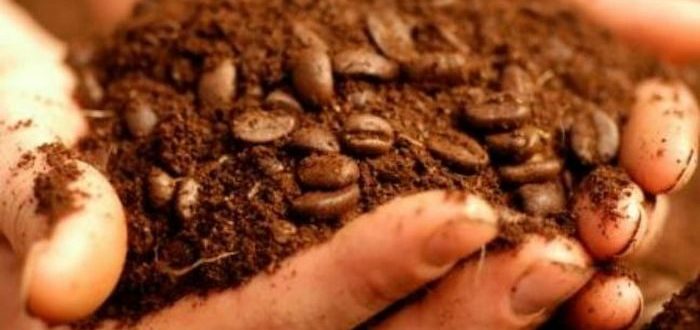
Coffee grounds are another organic top dressing that saturates the soil with nitrogen and improves its structure. This fertilizer is suitable for berry bushes, as well as roses, hydrangeas, magnolias and violets. Before use, coffee grounds are mixed with soil in a 1: 4 ratio and applied to the soil near the plant stems.
Banana peel
Banana peel is rich in potassium and calcium, therefore it is excellent as a fertilizer for berry crops. The peel is buried in the soil next to the plant, where it quickly decays. The same is done with the bananas themselves, which are overripe and no longer fit for food.
Rates and volumes
When calculating the dosage of mineral fertilizers, they are based on the recommendations of the drug manufacturer. An excess of substances leads to a deterioration in the quality of the crop, diseases, the accumulation of nitrates in fruits.
Signs of a nutrient deficiency
Lack of any nutrient affects on foliage... Regular inspection of plantings helps to recognize the problem in time and take action.
- With a lack of nitrogen, the foliage becomes shallow and yellow, covered with dark red spots... Flowers fall off, few fruits are tied. The plant weakens, new shoots grow short and thin.
- An excess of nitrogen, on the other hand, is manifested by an intense growth of green mass, dark green foliage and active formation of new shoots. However, flowering occurs with a delay, and the fruits grow small and slightly colored.
- With a lack of phosphorus, the leaves become shallow, dull, become bluish-green. Petioles and veins of the leaf turn red and crumble early. The fruits ripen slowly and taste sour. Shoots are underdeveloped.
- The lack of potassium is indicated by a red border on the leaves of black currant. Calcium deficiency slows down the growth of the root system, mucus appears on it.
Application methods
There are 2 ways to apply fertilizers: under the root and foliar. Let's tell you more about each of them.
Under the root
When applying dry dressings, nutrients are dissolved in the soil with irrigation water or rain.
Watering the bite zone fertilizers dissolved in water allows nutrients to penetrate to the roots faster.
In early spring, when there is a lot of moisture in the soil, the currants are fertilized with dry nutrient mixtures, in dry summer - with liquid ones.
Foliar method
Foliar dressing is spraying foliage with weak nutrient solutions. In this case, the elements are assimilated by leaf blades. The solutions are prepared weak to avoid leaf burns.
For example, in June it is good to carry out foliar feeding of currants with microelements. To do this, 5 g of potassium permanganate, 3 g of boric acid and 30-40 g of copper sulfate are diluted separately, in different containers, and then mixed in 10 liters of water. This solution is sprayed with currant bushes.
Top dressing depending on the type
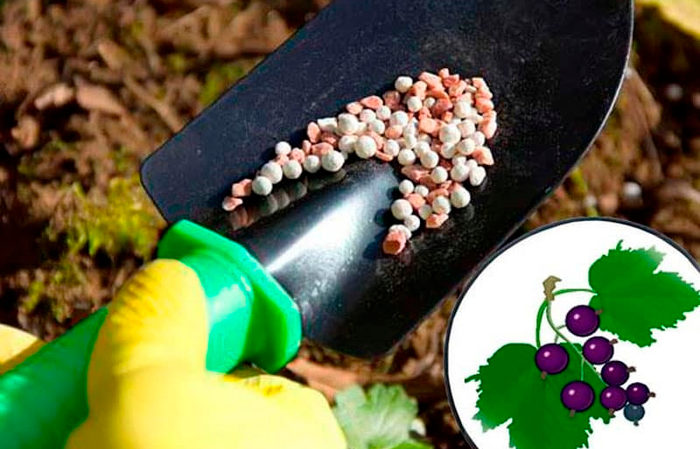
The fertilizing plan is built taking into account the type of culture. Black currants are fertilized 5 times per season. 4 dressings are enough for red and white. The fact is that colored varieties are distinguished by a more powerful root system, less demanding on the composition of the soil.
The general fertilization scheme is as follows:
- for the first time in the season, currants are fed in early spring, along with the melting of the snow;
- the second - during the flowering period;
- the third feeding is carried out during the formation of the ovary;
- the fourth - after harvesting;
- the fifth - a month before the onset of persistent cold weather.
Tips on the topic
The advice of experienced gardeners will help you not to make mistakes when applying fertilizers and provide the whole family with a supply of tasty and healthy berries:
- Fertilizers are stored in their original packaging in a dry room at a stable temperature. Solutions and mixtures are prepared according to the instructions.
- When working with drugs, observe safety precautions, use rubber gloves and goggles.
- Fertilize after plant rooting.
- Before applying top dressing (especially dry), the soil is well moistened.
- Spraying is carried out in dry weather early in the morning or in the evening to avoid burns on the leaves.
- Mineral fertilizers will not harm if you enrich the soil with humus. It is possible to determine whether there is enough of it on the site by the presence of earthworms. If they are, then everything is in order.
Conclusion
Top dressing of black currants in summer is an important stage in crop care.In June, she needs food and moisture. If you neglect these conditions, the harvest will not please. Black and colored currants respond well to feeding. The main thing is to apply fertilizers on time, use different types and observe the recommended dosages.
It should be remembered that dressings prepared according to folk recipes do not replace mineral fertilizers. It is better to alternate them or make them together.